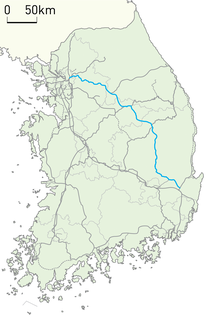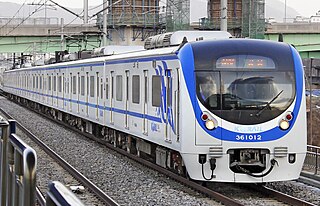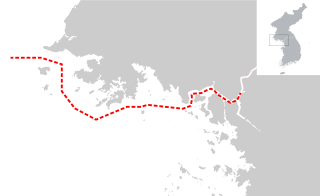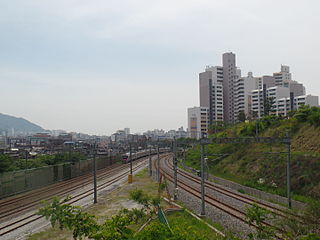
Incheon, formerly Jemulpo or Chemulp'o (제물포) until the period after 1910, officially the Incheon Metropolitan City, is a city located in northwestern South Korea, bordering Seoul and Gyeonggi to the east. Inhabited since the Neolithic, Incheon was home to just 4,700 people when it became an international port in 1883. Today, about 3 million people live in the city, making it South Korea's third-most-populous city after Seoul and Busan.

The Korea Railroad Corporation, branded as KORAIL, is the national railway operator in South Korea. Currently, KORAIL is a public corporation, managed by Ministry of Land, Infrastructure and Transportation.

The Jungang line is a railway line connecting Cheongnyangni in Seoul to Moryang in Gyeongju in South Korea, traversing central South Korea from the northwest to the southeast. It also referred to the rail line of the Seoul Metropolitan Subway from Yongsan station to Jipyeong station. Section from Cheongnyangni to Dodam was designated as higher-speed railway

The Gyeongchun Line is a regional rail line between Seoul and Chuncheon, South Korea, operated by Korail. Its name is derived from Gyeong and Chuncheon. It was completely reconstructed in the 2000s. Service on it has operated between Sangbong station on the Jungang Line in eastern Seoul and Chuncheon station, as part of the Seoul Metropolitan Subway system, since December 21, 2010. A class of regional rail service named ITX-Cheongchun began operations on February 28, 2012, linking Chuncheon to Cheongnyangni and Yongsan Stations.

The Gyeongwon Line is a railway line serving northeastern Gyeonggi Province in South Korea. The line is operated by Korail. The name of the line came from Gyeongseong (Seoul) and Wonsan, the original terminus of the line, in what is now North Korea.
Gwak Jae-u was a Korean military general and patriot from Uiryeong. He was called the "Red Robe General" after his habit of wearing a coat made of red silk. In 1592, nine days into the Imjin war, he formed a Righteous army to fight against the Japanese army. He originally did not have an official position, but King Seonjo of Joseon granted him a government position.

The Northern Limit Line or North Limit Line (NLL) – 북방한계선 – is a disputed maritime demarcation line in the Yellow (West) Sea between the Democratic People's Republic of Korea (DPRK) on the north, and the Republic of Korea (ROK) on the south. This line of military control acts as the de facto maritime boundary between North and South Korea.

Gangnam District is one of the 25 local government districts which make up the city of Seoul, South Korea. Gangnam translates to "South of the (Han) River". Gangnam District is the third largest district in Seoul, with an area of 39.5 km2 (15.3 sq mi). As of the 2017 census, Gangnam District had a population of 561,052. There is a high concentration of wealth in the district, with prices for an apartment as of 2020 nearly double those in the rest of Seoul. Gangnam district is generally referred to as a part of Gangnam School District Eight, along with Seocho District. This district shares half of Gangnam-daero Gangnam Station area with Seocho District, which is one of the most crowded places in Korea.

AREX is a South Korean commuter rail line that links Incheon International Airport with Seoul Station via Gimpo International Airport. The section between the two airports opened on March 23, 2007, and line was extended to Seoul Station on December 29, 2010. Long-distance Korea Train Express high speed trains started to use the line from June 30, 2014, but discontinued service in March 2018 due to low ridership.
Aju Group is a large South Korean chaebol (conglomerate), offering chemical, industry, logistic, financial, hotel and rental products.

Maoricicada, commonly known as black cicadas or mountain black cicadas, is a genus of cicada in the family Cicadidae. This genus is endemic to New Zealand.

Jungnang District (Jungnang-gu) is one of the 25 gu, or districts, of Seoul, South Korea. It is located on the north side of the Han River.

Mangu Station is a station on the Gyeongui-Jungang Line, and the Gyeongchun Line since 21 December 2010. The station was Seoul's main distribution center of charcoal briquettes in the 1950s and 1960s, extracted and manufactured in southern Gangwon province. These briquettes were widely used by people to weather harsh winters when Korea was a developing country and recovering from the Korean War. It is a station that still predominantly handles freight trains. It is very close to an E-Mart and Costco stores.

Mangu-dong is a dong, neighbourhood of Jungnang-gu in Seoul, South Korea.

The 2010 South Carolina Gamecocks football team represented the University of South Carolina in the 2010 NCAA Division I FBS football season. The team's head coach was Steve Spurrier, who was in his sixth season at USC. The Gamecocks played their home games at Williams-Brice Stadium in Columbia, South Carolina and were members of the East Division of the Southeastern Conference. The Gamecocks finished the season 9–5, 5–3 in SEC play to win the East Division. They earned their first appearance in the SEC Championship where they were defeated by Auburn 17–56. They were invited to the Chick-fil-A Bowl, where they were defeated by Florida State 17–26.
Mangu Deh is a village in Pir Bazar Rural District, in the Central District of Rasht County, Gilan Province, Iran. At the 2006 census, its population was 1,020, in 280 families.

The Donkey King is a 2018 Pakistani computer animated comedy film, directed by Aziz Jindani. The film features the voices of Jan Rambo, Ismail Tara, Hina Dilpazeer, Ghulam Mohiuddin, and Jawed Sheikh. It was released in Pakistan on 13 October 2018 by Geo Films and Talisman Studios. After its national success, it became the first Pakistani film to be dubbed into ten languages for multiple international theatrical releases, distributed worldwide by Annalisa Zanierato, for Pantera Film.

Maoricicada mangu is a species of cicada that is endemic to New Zealand. This species was first described by Francis Buchanan White in 1879.














